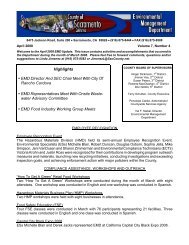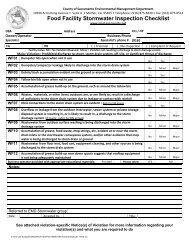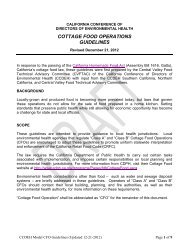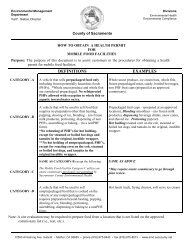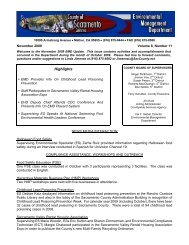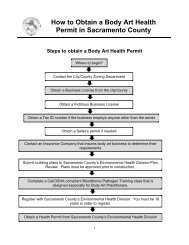California Water Well Standards, DWR Bulletin 74 ... - County of Glenn
California Water Well Standards, DWR Bulletin 74 ... - County of Glenn
California Water Well Standards, DWR Bulletin 74 ... - County of Glenn
- No tags were found...
Create successful ePaper yourself
Turn your PDF publications into a flip-book with our unique Google optimized e-Paper software.
c.STANDARDSPart I.GeneralSection 1. Definitionsl.AB.Monitoring <strong>Well</strong>. The term "monitoring well" is defined in Section 13712 <strong>of</strong> the <strong>California</strong><strong>Water</strong> Code as:"...any anificial excavation by any method for the purpose <strong>of</strong> monitoringfluctuations in groundwater levels, quality <strong>of</strong> underground waters, or theconcentration <strong>of</strong> contaminants in underground waters."roloration Hole (or Boring). An uncased temporary excavation whose purpose is the immediatedetermination <strong>of</strong> hydrologic conditions at a site.Enforcing Ageng. An agency designated by duly authorized local, regional, or State governmentto administer and enforce laws or ordinances penaining to the construction, alteration,maintenance, and destruction <strong>of</strong> monitoring wells.Section 2. Application to <strong>Well</strong> Type.These standards apply to all types <strong>of</strong> monitoring wells, except as prescribed in Sections 3,4, and 5, below.Before a change in use <strong>of</strong> a well is made, any standards for the new use must be complied with.Section 3. Exemptions for Unusual Conditions.Under certain circumstances the enforcing agency may waive compliance with these standards and prescribealternate requirements. These standards may be waived where they are impractical or ineffective because <strong>of</strong>unusual conditions or would result in an unsatisfactory condition or well function. In waiving any <strong>of</strong> thesestandards the enforcing agency shall, if at all possible, require measures be implemented to provide the sameor greater level <strong>of</strong> water-quality protection that would otherwise be provided by these standards.Section 4. Exclusions.Most standards in Part II, "Monitoring <strong>Well</strong> Construction," page 41, do not apply to "exploration holes."However, provisions <strong>of</strong> Section 7, "Reports," below and Part III, "Destruction <strong>of</strong> Monitoring <strong>Well</strong>s," page 50,do apply directly to exploration holes.Exploration holes for determining suitability <strong>of</strong> on-site domestic sewage disposal that are less than 10 feet indepth are exempt from the reporting and destruction requirements <strong>of</strong> these standards.Large volume excavations for determining the suitability <strong>of</strong> on-site domestic sewage disposal, such as backhoetrenches, that exceed ten feet in depth are exempt from the requirements <strong>of</strong> Part III <strong>of</strong> these standards.However, such excavations shall be backfilled with the excavated material or other suitable fill material andthe backfill compacted in lifts to attain at least 90 percent relative compaction in order to restore physicalconditions in the excavation as much as possible. If a layer or layers <strong>of</strong> material that serve to impede the



